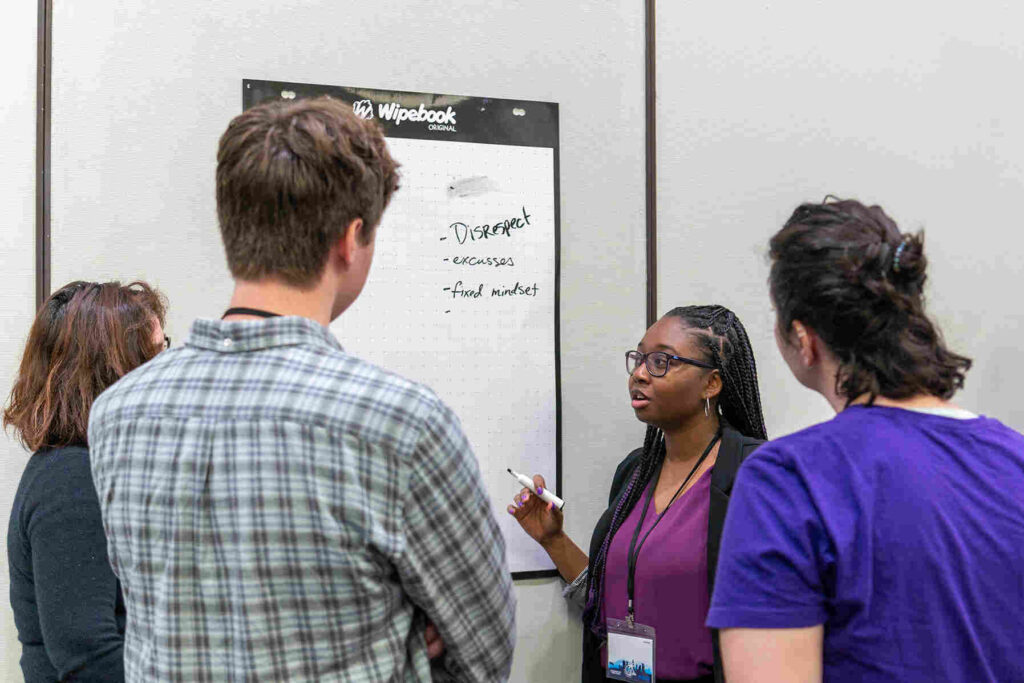November 2024

Teachers, you are the heart of impact in the classroom. Every change and success is influenced by the work you do with and for your students. As a math instructional coach, my role is to support teachers in achieving their unique visions, guiding them toward the tools and strategies that make those visions a reality in a student-centered classroom.
So, when was the last time someone asked you to envision your “perfect” classroom? What furniture would you choose? Where would you place windows? Would your walls be painted, covered in whiteboards, or filled with art? Where would your desk be?
This visioning exercise is one of my favorite warm-up activities from a professional development session that has stuck with me, sparking endless ideas about what my perfect teaching environment could look like. If the sky were the limit, what choices would I make to create an inspiring, effective space? And beyond the physical space, what would my ideal math lesson look like, sound like, feel like? What would my students be feeling as they leave—excited, puzzled, challenged, or all of the above?
Now, bring your vision back to your current classroom. It may look different from the perfect space you just imagined, but that does not mean you cannot work toward making aspects of your vision a reality. So, the question becomes: What can you do today to bring you closer to your ideal classroom and those lessons? And perhaps just as importantly, what practices are already moving you in that direction? My mission as a math coach is to help teachers build that bridge between their visions and today’s reality. This support is essential in helping teachers feel equipped and inspired to make their ideal classrooms a little more real each day.
Professional Development: Nurturing Teacher Growth
A key element I see moving my teachers forward is the regular, ongoing professional learning that fuels their growth. Just as sunshine and nutrients help a garden thrive, professional learning nourishes educators. It revitalizes your skills, introduces fresh approaches, and keeps you inspired to meet your students’ evolving needs. It also puts you in the seat and mindset of a student, something essential to keeping in touch with your young learners.
Some professional learning sessions introduce a new tool, like the recent webinar that opened my eyes to free virtual manipulatives. Others allow you to connect with colleagues facing similar challenges, offering different perspectives that bring new energy to familiar problems. Occasionally, you even attend a professional learning event that transforms your teaching approach entirely. Whether small or groundbreaking, these sessions are essential for the continued growth you seek for yourself and your students.
Here is another thought exercise from your temporary math coach: What would your perfect professional learning look like? What would actually be useful for you right now? What professional learning would you lead and plan? What is the best professional learning you have ever attended? What made it so valuable?
As we adopt the CPM curriculum this year, I find myself especially excited to bring my experience as a former CPM Teacher Leader to my current coaching role. I know that with CPM’s on-demand courses and the wealth of insights offered by the CPM Professional Learning Team, teachers have access to a deep pool of resources. This access empowers you to explore and implement the curriculum’s best practices in your own classroom. In my role as a coach, I support teachers as they implement, helping to make sense of new strategies and integrate them into everyday teaching. A coaching partnership allows teachers to grow and empowers them to make an even greater impact in their classrooms. It comes back to embracing the team-based student mindset. Teachers, you do not have to do everything on your own.
Coaching Cycles: Focused, Student-Centered Support
Here is your math coach again to ask you, “What are your current goals for your students? How do they track and monitor their own progress toward those goals? What evidence do you use to ensure your students are successfully meeting their learning targets, and how does that evidence drive your lesson planning?”
At our school site, we have found tremendous success in using student-centered coaching cycles to empower teachers and enhance student outcomes. These cycles begin with a teacher selecting a specific math standard as the focus. Together, the coach and teacher analyze student evidence and plan targeted instruction, with regular check-ins to monitor student progress and make any necessary adjustments. Since adopting the CPM curriculum, these cycles have become essential, as teachers and students both adjust to CPM’s spiraled approach in which concepts are developed over time.
For me as a coach, these cycles are some of the most meaningful work we do. Coaching cycles help teachers and students trust CPM’s foundational pillar of “proficiency over time,” supporting teachers as they navigate the curriculum’s spiraled approach. The teachers I work with find these cycles invaluable—not only for measuring lesson impact, but for the opportunity to work closely with their students in a way that feels responsive and impactful. This deeper, student-centered approach goes far beyond surface-level support, providing real-time insights that allow teachers to make purposeful adjustments and ensure students stay on track toward their goals.
Conclusion: Teachers as the Heart of Impact and Influence in the Classroom
At the classroom level, there are countless strategies we see working well for students, such as study team and teaching strategies, differentiation, team roles, and vertical non-permanent writing surfaces, to name a few. Ultimately, it all comes back to the bridge between the teacher’s vision and the reality of the classroom. Are you nurturing your growth through collaboration, professional learning, and student-centered coaching? I encourage you to find ways to empower yourself with the tools and support you need to make a lasting impact. When we invest in teacher vision and growth, we invest in our students’ futures. I have seen this approach work, and, as a math instructional coach, I know it is what makes all the difference.


